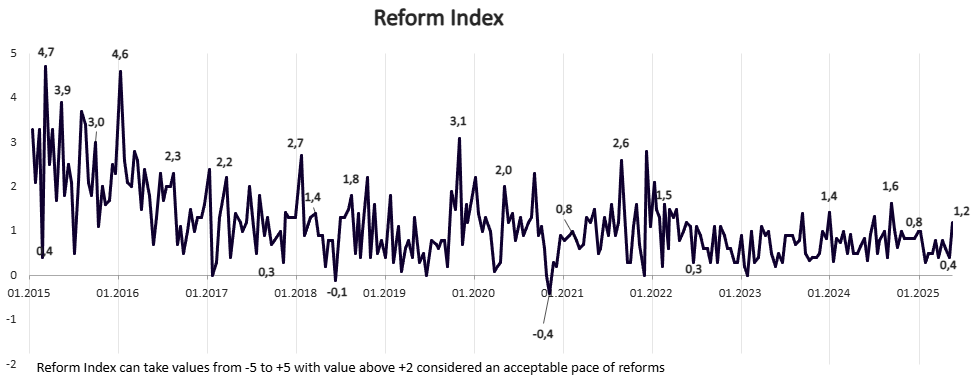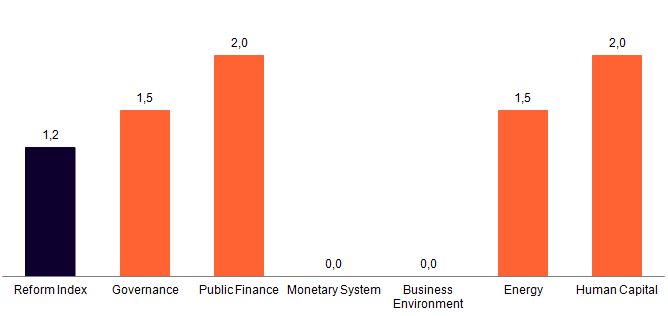From May 5 to May 18, seven reform-oriented regulations were included in the Reform Index. All of them received positive evaluations from experts. The Index score in issue 264 is 1.2 points. In the previous period, it stood at 0.4 points.
Graph 1. Dynamics of the Reform Index

Graph 2. Values of the Reform Index and its Components in the Current Assessment Round

Official employment abroad to be recognized in pension calculations, +2.5 points
Previously, when determining pension eligibility, only work experience gained in Ukraine and in countries that had agreements with Ukraine on mutual recognition of employment history was taken into account. Now, according to Government Resolution No. 562, all Ukrainians who have officially worked abroad can expect their work experience to be considered when applying for a pension in Ukraine. However, only insurance contributions paid within Ukraine will be counted (since the pension amount depends on both the length of employment and the salary from which insurance contributions were paid).
To have foreign work experience recognized, individuals will need to submit documentation to Ukraine’s Pension Fund proving their participation in another country’s pension system. Citizens who worked in Russia or Belarus must provide a written statement confirming that they are not receiving pensions from those countries. No official documents from Russia or Belarus are required, as Ukraine has ceased all document exchange with those pension authorities since the start of the war.
Information about the Reforms Index project, the list of Index experts and the database of the regulations assessed are available here.
Expert commentary
Inna Studennikova, The Center of Public Finance and Governance at Kyiv School of Economics
“Resolution No. 562 introduces the possibility of counting periods of employment abroad toward one’s pensionable work record — even if Ukraine does not have a formal agreement with the country in question. This work record is crucial for determining eligibility for an old-age pension. This is a significant simplification for millions of Ukrainians who worked abroad — whether due to war or long-term labor migration—but were unable to verify their work history through the established procedures. Without a clear mechanism, these citizens either lost their right to a pension or had to purchase qualifying service at their own expense. The resolution is intended to encourage citizens to return home.
The resolution outlines two separate procedures: one for recognizing employment periods in former Soviet republics before January 1, 1992, and another for confirming work experience in other foreign countries. Proof of foreign work history can be submitted through official documents such as certificates or extracts, or obtained via formal requests from the Pension Fund of Ukraine (PFU) and the Ministry of Foreign Affairs to foreign authorities. To confirm Soviet-era work experience before 1992, individuals may submit a declaration stating they are not receiving a pension from another country or provide an explanation for the lack of supporting documentation.
However, income earned abroad is not factored into the calculation of pension amounts — it only affects whether a person qualifies for a pension. There is also a risk of refusal or delayed responses from foreign authorities, which can complicate or delay the recognition of work experience. Additionally, the self-declaration mechanism regarding pension payments from other countries could be misused by bad-faith applicants.”
Procedure for preparing and implementing public investment projects, +2 points
In early May, a government resolution adopted in February came into effect, setting out procedures for preparing, evaluating, and implementing public investment projects and programs. The document functions as a step-by-step guide outlining the key stages a public investment project must pass through — from planning to execution.
The resolution stipulates that public investment projects may qualify for state support if they are included in a sectoral or unified public investment project portfolio. To be included in such a portfolio, projects must undergo a preliminary evaluation by authorized local, regional, or national bodies and meet specific established criteria.
In particular, these projects must include strategic, economic, financial, managerial, and commercial justification, as well as a preliminary feasibility study (pre-FS) or a full feasibility study (FS) for projects worth over UAH 50 million. Large-scale projects exceeding UAH 400 million require additional analyses — such as environmental, climate, and market impact assessments. If the preliminary FS receives a positive evaluation, the project is included in the sectoral portfolio. Following another expert review, the project may be admitted to the main unified public investment project portfolio, making it eligible for state funding.
Projects worth up to UAH 50 million can be implemented immediately after completing the preliminary feasibility study, without the need for inclusion in either the sectoral or unified national project portfolio. Projects costing over UAH 50 million that do not require state funding may proceed once they are included in the sectoral portfolio, without mandatory inclusion in the unified national portfolio.
Expert commentary
Oleksandra Betliy, Leading Research Fellow and Project Coordinator, Institute for Economic Research and Policy Consulting (IER)
“In December 2023, the government began building an effective public investment management system. The goal was to create a transparent, strategically aligned, efficient public investment system with clear project selection, effective financing, and monitoring mechanisms. Following the adoption of the Reform Roadmap, pilot approaches were implemented throughout 2024 to establish the Strategic Investment Council, which is tasked with setting priorities for public investments, defining project selection criteria, and forming the Unified Project Portfolio through applications submitted via the DREAM platform. In January 2025, the government systematized these developments, and MPs adopted the proposed amendments to the Budget Code. To implement the new law, the Cabinet of Ministers approved several resolutions on February 28, establishing new approaches to public finance management. These reforms were structural benchmarks of the IMF Program, and their implementation enabled Ukraine to successfully complete the seventh and eighth reviews under the IMF Program.
In particular, on February 28, the government approved (officially published in the Uryadovyi Kurier newspaper on May 10 – ed.) the procedures for the preparation, evaluation, and implementation of public investment projects and programs at the national, regional, and local levels, as well as the procedure for forming the unified public investment project portfolio of the state (region, territorial community) and the sectoral (industry-specific) project portfolio of the state (region, territorial community). It also approved the procedure for developing and monitoring the implementation of the state’s medium-term priority public investment plan and preparing public investment projects and programs under the new methodology (starting in May 2025).
The adopted changes are intended to support the implementation of a unified public investment management system. As a result, by increasing transparency and directing funds toward priority projects, the efficiency of spending on investment projects is expected to improve.
At the same time, the government has already begun to address several challenges. Among them are the limited capacity of local authorities and other stakeholders to prepare high-quality investment projects, as well as a lack of understanding of the reform’s purpose. To overcome these issues, the government will train communities, explain the reform to them, and establish project preparation offices. Capacity challenges also exist not only at the local level but within line ministries as well. Effective public investment management requires the development of a robust IT solution. Changes to the DREAM system are still ongoing. Another challenge lies in unreformed legislation and inefficient practices in the construction and public procurement of construction works, which diminishes participants’ interest in such tenders.”
Polaris Mariia Lukyanova, Fiscal Decentralization Team Leader, Polaris Program
“The government resolution adopted at the end of February, which regulates public investment management, was only published and entered into force in May.
Since, according to the Action Plan for implementing the Roadmap for Public Investment Management Reform for 2024–2028, the year 2025 is a transitional period for introducing the new public investment management system, and work on medium-term budget planning and the preparation of budgets at all levels for 2026 must take these changes into account, a range of significant challenges lies ahead.
First, there are tight timeframes for preparing high-quality public investment projects. There is a risk that Ukraine may ‘repeat the same mistakes,’ as highlighted in the annual RDNA 4 report for 2024, which stated: “Line ministries and subnational authorities had less than a month to submit project proposals in line with the new guidance (set by Resolution No. 903…)… The limited time for preparation of project proposals undoubtedly impacted on quality: some projects are not yet aligned with stated priorities; and some are not implementation ready.’
Second, staffing on the ground is a critical issue. While a dedicated structural unit responsible for managing public investments can be created without increasing the overall headcount of local self-government bodies — by assigning additional responsibilities to existing departments—providing expert evaluations of public investment projects on the ground may lead to potential conflicts of interest.
Third, both the resolution and the Procedure for Preparing Public Investment Projects and Programs state that the new public investment management procedures are recommendatory for project preparation at the local level, and mandatory only if a project or program receives funding from the state budget. Since local initiatives must go through a lengthy process to access state budget financing, there is a risk of centralization of financial resources for reconstruction and development, as well as a potential decline in the absorption capacity of local self-government bodies.
The public investment management reform is highly ambitious. It is crucial to coordinate all stakeholders (local self-government bodies, regional state administrations, military administrations, sectoral ministries) and the expert community to make the process as smooth as possible for communities and regions, especially during the transitional phase. As early as this fall, a preliminary assessment of the reform’s implementation on the ground can be carried out, followed by a ‘lessons learned’ exercise.”
Launch of a natural gas consumption information database, +1.5 points
Data on natural gas consumption will now be collected and published in a unified information database of natural gas consumers. Its creation is mandated by Government Resolution No. 547. This centralized state-run system will compile information on all residential and non-residential natural gas consumers. It will also track volumes of gas production, transportation, distribution, storage, supply, and consumption — both of imported gas and gas from domestic sources.
The database is owned by the Ministry of Energy, while its administration is handled by Gas Transmission System Operator of Ukraine LLC.
Roman Nitsovych, Research Director, DiXi Group
“Regulating the operation of the gas consumption database is a step toward implementing a requirement set out in the Law on Ensuring Commercial Metering of Natural Gas, which was introduced back in 2021.
These new approaches will give the government a clearer picture of both physical and commercial gas flows across all stages of the supply chain — extraction, transportation, distribution, storage, supply, and consumption. This, in turn, will support the development of policies aimed at improving market efficiency, optimizing infrastructure use, and providing targeted protection for vulnerable consumers.
The database will also help lay the groundwork for a competitive retail market once martial law restrictions are lifted. Since August 1, 2020, all household consumers have had the formal right to choose their gas supplier. However, Naftogaz currently has a de facto monopoly, and legislation prohibits upward price adjustments in line with market conditions. In particular, with the help of such a data hub, suppliers can analyze a potential new customer’s profile (including consumption history) and make informed decisions about whether to work with that customer. This, in turn, reduces the risks taken on by new suppliers and, consequently, lowers the commercial markup to some extent. In other words, if a series of market liberalization steps is implemented, the deployment of the database will ultimately benefit consumers.”
Reform Index from VoxUkraine aims to provide a comprehensive assessment of reform efforts by Ukraine’s authorities. The Index is based on expert assessments of changes in the regulatory environment in six areas: Governance, Public Finance, Monetary system, Business Environment, Energy, Human Capital. Information about the Reforms Index project, the list of Index experts and the database of the regulations assessed are available here.
Attention
The author doesn`t work for, consult to, own shares in or receive funding from any company or organization that would benefit from this article, and have no relevant affiliations



